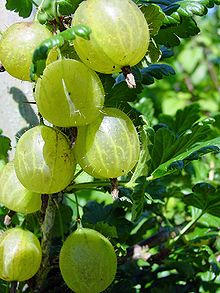How to Grow Gooseberries – A Guide to Growing Gooseberries
 Gooseberries
Gooseberries
Gooseberries are often thought to be easy to grow but they really need care to produce plants that will bear a good crop of easily pickable berries each year. They are not a popular as they used to be in the 19th century when gooseberry clubs and shows abounded. But they are making a comeback.
Recommended Gooseberry Varieties
- Invicta is a large fruited pale green dessert/culinary variety. It is widely available and very popular. It is very vigorous but prickly.
- Leveller is a popular green/yellow dessert/culinary variety with very large fruit often chosen for showing.
- Whinham’s Industry is a good all-rounder red variety not as large or sweet as Leveller but with an excellent flavour and good yields . It does well in shady conditions and heavy soils.
Eating Gooseberries
Gooseberries are well worth growing for their excellent flavour. Desert varieties are sweet and flavoursome served with cream and sugar or fresh in many dessert and gateaux recipes. Culinary varieties make delicious cooked desserts, jams and preserves and are a good accompaniment for duck.
Gooseberry Pests and Diseases
- Birds, particularly bullfinches often peck out the buds of gooseberries during the winter so netting the bushes will protect them. Fine thread wound around the bushes will also keep small birds off. Bushes will need to be netted down to the ground to keep the birds from taking the fruit as it ripens. They are, therefore, best grown in a fruit cage.
- Gooseberry sawfly caterpillars can be a problem and will strip the leaves from a plant very quickly. Check the leaves regularly and remove any caterpillars you find.
- Aphids often attack the growing leaf shoots of gooseberries and should be removed as soon as spotted
- Mildew is a frequent problem for gooseberries but there are some mildew-resistant varieties available.
Cultivating Gooseberries
- Gooseberries like a sunny position but some varieties grow in shade or even against a north-facing wall. Gooseberry bushes have impressive thorns. The can be growing as a half-standard in a container to make pruning easier. Gooseberries can grow into a very thorny, tangled shrub so keeping them pruned correctly is very important.
- They should be cultivated in the same way as blackcurrants . They like a rich moist soil so don’t let them dry out and water regularly. Irregular or heavy watering after the plants have dried out can cause the fruits to split. Mulching with well-rotted manure or compost will help to retain food and moisture in the soil.
- Gooseberries fruit on a permanent framework of branches and should be prune in winter in the same way as redcurrants. Prune them into a cup shape with and open centre, this helps to prevent mildew and makes the fruit easier to pick. Remove any lower branches that will reach the soil when loaded with fruit. In the summer prune back the side shoots to about five leaves. This lets in light and air and encourages fruiting spurs to develop .
Harvesting Gooseberries
Gooseberries are slow to ripen, sharp when small and young, sweet when mature. Take your first harvest in late May or early June. These fruits are excellent for pies, crumbles and tarts. Leave the remaining fruits to swell and ripen fully for eating fresh . Not all fruits will ripen at once so pick them over a few times taking those that are well coloured and yield to a gentle squeeze.
Storing Gooseberries
- Gooseberries freeze well then they can be used throughout the year .
- They have a high pectin content which makes the very good for making delicious jam, especially nice if you add some elderflower cordial near the end of the cooking time.



